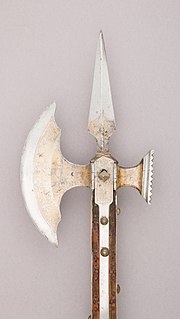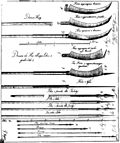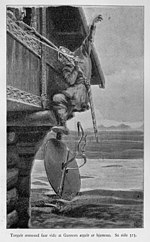 | English approximation: /dʒiː/ jee, Chinese: 戟; pinyin: jǐ) was a Chinese polearm, sometimes translated into English as spear or halberd, though they are... 6 KB (650 words) - 18:04, 21 April 2024 |
 | The three most common types of Chinese polearms are the ge (戈), qiang (槍), and ji (戟). They are translated into English as dagger-axe, spear, and halberd... 15 KB (1,588 words) - 23:11, 17 April 2024 |
 | Ngao (ง้าว,ของ้าว) is a polearm that was traditionally used during the 18th century in Thailand. Stick fighting List of premodern combat weapons List... 718 bytes (58 words) - 04:33, 9 December 2023 |
 | Bill (weapon) (redirect from Bill (polearm)) trimming tree limbs, which was often repurposed for use as an infantry polearm. In English, the term 'Italian bill' is applied to the similar roncone... 5 KB (685 words) - 11:38, 15 March 2024 |
 | Many of the polearms used in Scotland up to the beginning of the 16th century were similar to those used in other parts of the world; however, a number... 3 KB (348 words) - 05:22, 22 April 2022 |
 | Halberd (category Medieval polearms) halberd (also called halbard, halbert or Swiss voulge) is a two-handed polearm that came to prominent use from the 13th to 16th centuries. The halberd... 18 KB (2,174 words) - 23:28, 2 May 2024 |
 | Poleaxe (redirect from Pollaxe (Polearm)) poleaxe (also pollaxe, pole-axe, pole axe, poleax, polax) is a European polearm that was used by medieval infantry. Most etymological authorities consider... 7 KB (866 words) - 11:37, 17 April 2024 |
 | War scythe (category Polearms) A war scythe or military scythe is a form of polearm with a curving single-edged blade with the cutting edge on the concave side of the blade. Its blade... 7 KB (831 words) - 22:50, 17 April 2024 |
 | Lucerne hammer (category Medieval polearms) The Lucerne hammer (/luˈsɜːrn/ loo-SURN) is a type of polearm which was popular in Swiss armies during the 15th to 17th centuries. It was a combination... 2 KB (218 words) - 22:06, 7 August 2023 |
 | Naginata (category Polearms of Japan) The naginata (なぎなた, 薙刀) is a polearm and one of several varieties of traditionally made Japanese blades (nihontō). Naginata were originally used by the... 20 KB (2,166 words) - 11:26, 17 April 2024 |
 | Fauchard (category Polearms) A fauchard is a type of polearm which was used in Europe from the 11th through the 17th centuries. In later use fauchards became ornamental and ceremonial... 6 KB (610 words) - 11:31, 17 April 2024 |
 | Partisan (weapon) (category Polearms) A partisan (also known as a partizan) is a type of polearm that was used in Europe during the 16th, 17th, and 18th centuries. It consisted of a spearhead... 2 KB (201 words) - 22:31, 4 March 2024 |
 | Dagger-axe (category Chinese polearms) The dagger-axe (Chinese: 戈; pinyin: gē; Wade–Giles: ko) is a type of polearm that was in use from the Longshan culture until the Han dynasty in China... 5 KB (557 words) - 22:45, 17 April 2024 |
 | Bardiche (category Medieval polearms) bardiche /bɑːrˈdiːʃ/, berdiche, bardische, bardeche, or berdish is a type of polearm used from the 14th to 17th centuries in Europe. Ultimately a descendant... 6 KB (679 words) - 08:51, 16 April 2024 |
Sovnya (category Polearms) A sovnya (Russian: совня) is a traditional polearm used in Russia. Similar to the glaive, the sovnya had a curved, single-edged blade mounted on the end... 1 KB (92 words) - 18:17, 15 March 2024 |
 | Guandao (category Chinese polearms) A guandao is a type of Chinese polearm that is used in some forms of Chinese martial arts. In Chinese, it is properly called a yanyuedao (偃月刀; lit. "reclining... 12 KB (1,681 words) - 17:33, 17 April 2024 |
 | Ranseur (category Polearms) A ranseur, also called roncone, was a polearm similar to the partisan used in Europe up to the 15th century. It was still seen in court as a ceremonial... 1 KB (176 words) - 11:15, 17 April 2024 |
Spear (category Polearms) A spear is a polearm consisting of a shaft, usually of wood, with a pointed head. The head may be simply the sharpened end of the shaft itself, as is... 49 KB (6,131 words) - 04:48, 3 May 2024 |
Bec de corbin (category Medieval polearms) de corbin (Modern French: Bec de corbeau, [bɛk də kɔʁ.bo]) is a type of polearm and war hammer that was popular in late medieval Europe. The name is Old... 2 KB (261 words) - 15:12, 13 April 2024 |
 | Guisarme (category Polearms) A guisarme (sometimes gisarme, giserne or bisarme) is a polearm used in Europe primarily between 1000 and 1400. Its origin is likely Germanic, from the... 4 KB (532 words) - 11:28, 17 April 2024 |
 | Spetum (category Polearms) A spetum is a polearm that was used in Europe during the 13th century. Other names include chauve souris, corseca, corsèsque, korseke, runka, and rawcon... 2 KB (261 words) - 11:43, 17 April 2024 |
 | Xyston (category Polearms) elasticity. Ancient Macedonian military Hellenistic armies Dory (spear) Kontos Polearm Sarissa Markle 1977, p. 324. Markle, Minor M. (1977). "The Macedonian Sarissa... 9 KB (426 words) - 22:51, 17 April 2024 |
 | Glaive (category Medieval polearms) distinctive design and versatile combat applications. It is similar to other polearms such as the war scythe, the Japanese naginata, the Chinese guandao, the... 8 KB (1,035 words) - 23:33, 23 April 2024 |
Man catcher (category Polearms) A man catcher, also known as catchpole, is a type of polearm. It was used in Europe as late as the 18th century.[citation needed] The European design... 5 KB (640 words) - 06:38, 9 May 2024 |
 | azagaie; Spanish: azagaya; Italian: zagaglia; Middle English: lancegay) is a polearm used for throwing, usually a light spear or javelin made up of a wooden... 3 KB (315 words) - 17:34, 17 April 2024 |
 | Atgeir (category Medieval polearms) atgeir, sometimes called a "mail-piercer" or "hewing-spear", was a type of polearm in use in Viking Age Scandinavia and Norse colonies in the British Isles... 3 KB (354 words) - 15:13, 2 May 2024 |
 | Lochaber axe (category Polearms) defense against cavalry and as a pike against infantry. Like most other polearms of the time, it consisted of two parts: shaft and blade. The shaft was... 5 KB (567 words) - 11:34, 17 April 2024 |
Spontoon (category Medieval polearms) the variant spelling espontoon or as a half-pike, is a type of European polearm that came into being alongside the pike. The spontoon was in common use... 4 KB (595 words) - 11:35, 17 April 2024 |
Monk's spade (category Chinese polearms) Japanese: getsugasan; "Zen Staff"), also called a Shaolin Spade, is a Chinese polearm consisting of a long pole with a flat spade-like blade on one end and a... 2 KB (210 words) - 22:50, 17 April 2024 |

